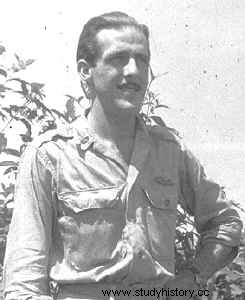THOMAS B. McGUIRE

"Eight Behind"
Thomas B. McGuire Jr. was born on August 1, 1920, in San Antonio (Texas). After being commissioned in February 1942, he was assigned to the air fleet based in Alaska where encounters with Japanese aircraft were rather rare.
In March 1943, he joined the 49th Fighter Group, attached to the 5th Air Force, stationed in Australia.Here too, he was not better able to get to know aviation This situation lasted until August 1943, when he was called up to form the new 431st Fighter Squadron of the 475th Fighter Group.
This unit began its missions above Wewak and, Without wasting a moment, McGuire got into the heart of the matter.On August 18, he claimed three Japanese fighters (two Zeros and a Tony - the Zeros were probably Oscars, since the Imperial Navy was not represented in Wewak at that time. Three days later, thanks to a double (two Zeke or Oscar), he becomes an ace, according to the American criteria. As we can see, the young 23-year-old Texan wasted no time!
On October 17, three Zekes fell in flames in Oro Bay, carrying his prize list to 13 confirmed wins. He adds three Val, on December 26, and ends the year 1943 with 16 victories in four and a half months! However, things don't always turn out for the best, as in the fight on October 17, Thomas McGuire is shot down by a Zero and has to parachute out. Slightly wounded, he was sidelined for two months.
The first half of 1944 brought little new success, as the Japanese air force had deserted the skies of New Guinea. He shot down his fifth victim of the year 1944, on July 17 (an Oscar above Lolobata).
Shortly later, his unit was transferred to the Philippines where fighting was frequent and tough.
It was then that the Texan embarked on the race to dethrone Dick Bong, a competition which would make him famous, but which earned him the unpleasant nickname of “Eight behind”. Because every time McGuire comes back with a victory, Bong, who is also from the 5th Air Force and who is also fighting in the Philippines, has a bad habit of doing the same, which makes the gap between the two aces remains almost always at the same level.
On December 13, McGuire shot down a Jack over the island of Negros. At his side, another P-38 does the same. The latter is, of course, piloted by Richard Bong!
McGuire takes off on December 25 to escort bombers over Malabacat airfield. Twenty Jaoli fall by surprise on the Ft 38. McGu ire shoots down three. It was his 34th victory... The next day, he escorted B-24s over Clark Field and 4 A6M5s fell in flames. 38 wins, two behind; Bong has 40. Three days later, on December 29, Richard Bong is repatriated to the United States. The war is over for him. McGuire now has a free hand to fulfill his big dream of becoming America's ace of aces. Alas, it never will.

At 6:20 a.m. on January 7, 1945, he took off with Lieutenant Thropp, Major Rittmayer and Captain Weaver for a mission over Fablica Airfield, Negros Island. Around 7 a.m., the three P-38s arrived in sight of the field and saw an isolated Zero. It is actually an Oscar, piloted by Warrant Officer Sugimoto of the 5th Sentai, who is returning from a mission. It is not completely isolated, for it has shared a route with a Frank piloted by Staff Sergeant Fukuda of 71st Sentai which, at this moment, is in the process of landing at Maflapie.
McGuire veers left on the first Japanese, followed by his three wingmen. What happened next ? The testimonies differ. Weaver claims that the Zeke (actually the Oscar) turned very sharp and the wings of McGuire's P-38 broke off from the twist. Fukuda who saw the fight meanwhile regained speed and altitude, saw Sugimoto open fire in a frontal pass. The causes are perhaps a little mysterious, but the result is indisputable. The wings shattered, the P-38 crashed, killing Thomas McGuire who will forever remain "Two Behind".
